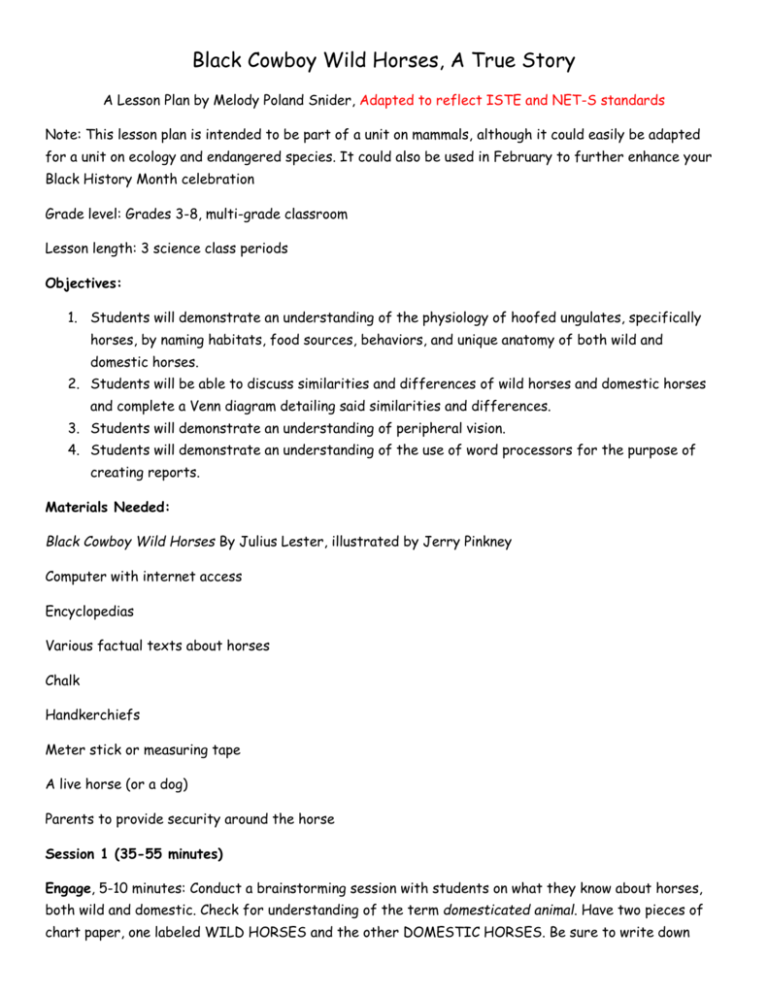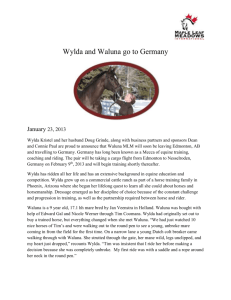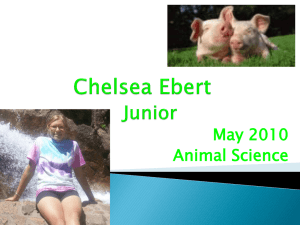Black Cowboy Wild Horses modified ITSE NETS lesson - 3
advertisement

Black Cowboy Wild Horses, A True Story A Lesson Plan by Melody Poland Snider, Adapted to reflect ISTE and NET-S standards Note: This lesson plan is intended to be part of a unit on mammals, although it could easily be adapted for a unit on ecology and endangered species. It could also be used in February to further enhance your Black History Month celebration Grade level: Grades 3-8, multi-grade classroom Lesson length: 3 science class periods Objectives: 1. Students will demonstrate an understanding of the physiology of hoofed ungulates, specifically horses, by naming habitats, food sources, behaviors, and unique anatomy of both wild and domestic horses. 2. Students will be able to discuss similarities and differences of wild horses and domestic horses and complete a Venn diagram detailing said similarities and differences. 3. Students will demonstrate an understanding of peripheral vision. 4. Students will demonstrate an understanding of the use of word processors for the purpose of creating reports. Materials Needed: Black Cowboy Wild Horses By Julius Lester, illustrated by Jerry Pinkney Computer with internet access Encyclopedias Various factual texts about horses Chalk Handkerchiefs Meter stick or measuring tape A live horse (or a dog) Parents to provide security around the horse Session 1 (35-55 minutes) Engage, 5-10 minutes: Conduct a brainstorming session with students on what they know about horses, both wild and domestic. Check for understanding of the term domesticated animal. Have two pieces of chart paper, one labeled WILD HORSES and the other DOMESTIC HORSES. Be sure to write down both facts and misconceptions offered. As each idea is offered, ask which paper it belongs on, or if it should be written on both papers. There should be numerous overlapping facts. Resource for this idea: http://www.pbs.org/wnet/nature/lessons/cloud-in-the-classroom/lesson/31/ 5 minutes: do a mini-author study on Julius Lester. Refer to the following website (Text included at the end of this lesson) http://www2.scholastic.com/browse/contributor.jsp?id=3308 for facts on his heritage as an African-American and his ancestors who served as slaves, his work as a writer and musician, and his advice for young writers. Explore, 20-30 minutes: Read the book Black Cowboy Wild Horses as a shared reading activity. If you do not have a copy for at least every two or three students, perhaps you can project the pages on a screen. The illustrations are almost as important to this lesson as the text, so it is important that every eye be on the pages as you go along. Evaluate, 10 minutes: go back to the chart papers. Ask the students, after reading the book, if there are any facts they want to add to either paper. Add the additional facts. Ask the students if there is anything on the papers that they have discovered, after reading the book, that were misconceptions. Cross out the misconceptions with a differently colored pen. Hand out the blank Venn diagrams (found in a second attachment to this lesson plan). Have the students fill them out, using the chart papers as a reference. Session 2 (40-50 minutes) Explore, 20-25minutes: Announce to the class that they will be presenting a newscast on wild horses. Divide the class into groups of two or three and assign them different parts of the newscast. Choose from the following list for group assignments (These assignments vary widely in difficulty to accommodate a grades 3-8 classroom. If the class is all upper grades, combine some of the simpler assignments, such as age, habitat and predators) : Resource for this idea: http://www.pbs.org/wnet/nature/lessons/cloud-in-the-classroom/lesson/31/ 1. Define the following terms: mustang, mare, stallion, foal, colt, filly, pinto, calico, palomino, bluff, plains, ravine, corral, whinny, skittered, milled, remorse 2. Habitat (include geography where they are found today) of the wild horse 3. Diet (if upper grader is given this section also assign what modifications the horse possesses to live on grass and why humans cannot live on grass) 4. Age 5. Eyesight 6. Predators and how wild horses detect them and protect themselves 7. Communication 8. Care of the young 9. Behaviors that remind us of human behavior 10. History of horses in America 11. How the habits of wild horses should be considered when caring for a domestic horse 12. What is being done today to protect the wild horse? Have students refer to encyclopedias and various books you have gathered on horses. NET # 3 Resource and Information Fluency NET #5 Digital Citizenship They can also refer to the following websites: Horse history http://mysite.verizon.net/mmaidens/ Lessons for caring for domestic horses from wild horses http://www.petfinder.com/pet-care/lessons-wildhorse.html Montana herd of wild horses http://www.blm.gov/mt/st/en/fo/billings_field_office/wildhorses.html Black Hills Wild Horse Sanctuary http://www.gwtc.net/~iram/ International Society for the Protection of Mustangs and Burros http://www.ispmb.org/ Information on wild horses http://www.wildhorses.com/ Wild horse facts http://www.tide-mark.com/horses_facts.html Bureau of Land Management Wild Horse and Burro Program http://www.blm.gov/wo/st/en/prog/wild_horse_and_burro.html How horses see http://www.horses-and-horse-information.com/articles/horse-eyes.shtml Horse vision http://horsehints.org/HorseVision.htm Explain, 20-25 minutes: Have the students present their sections of the newscast to the rest of the class. Place a desk and two or three chairs, depending on the number of students in each group, at the front of the room by the blackboard. Choose two students to be “anchors” and have them stay at the desk throughout the newscast to announce the other “reporters” as they come forward to present. Have the students take notes on the presentations as they are given using the worksheet included at the end of this lesson. (Alternatively, the teacher could be the anchor, but this may make it more challenging to assess each presentation. Note: EVALUATE is happening during this activity as well as EXPLAIN.) Resource for this idea:http://www.pbs.org/wnet/nature/lessons/cloud-in-the-classroom/lesson/31/ NET #1 Creativity and Innovation Bring a digital video camera and have the students take turns filming the newscasters and reporters. The resulting newscast could be posted on the students private classroom wiki for viewing later when students need to expand notes for their paper or study for a quiz. Session 3 Elaborate, 1 hour: Have student’s parent bring horse to school. (This could be done with a dog as well, if horses are in short supply at your school! Fortunately, my art teacher raises horses.) Announce to the students that they will be testing the horse’s peripheral vision, to understand how well a horse can detect predators using sight. Go over safety issues, such as not to stand behind the horse. Draw a chalk line several feet all the way around the horse that the students are not allowed to cross during the experimental stage of this activity. Have a parent hold the horse’s head steady, and looking straight ahead. Demonstrate that you can watch a horse’s eyes move when he is watching a moving object. Provide handkerchiefs, sidewalk chalk, meter sticks and or measuring tape. Divide students into groups of three or four and have them brainstorm among themselves how to detect and measure the horse’s peripheral vision. Have students record their findings in their science notebooks. After the experiments are completed, have the students compare their findings and discuss the reasons for any differences. To prevent a full-scale mutiny, be sure and give petting time before heading back into the classroom. Resource for this idea: http://www.usc.edu/CSSF/History/2006/Projects/J1027.pdf Session 4, 5 and 6 Evaluate: 3-4 hours spread over 3 sessions NET #5 Digital Citizenship NET #6 Technology Operation and Concepts Using their notes on the newscast and referring back to the previously given resources in Session 2, have students write a report on horses. Grades 3-4 should create a non-fiction, informational construction paper book about horses. Advanced learners in grades 3 and 4 should type their sentences and tape them to the appropriate pages in their book. Grades 5-6 should write a minimum of 5 paragraphs in a typewritten spool paper report. Grades 7-8 should write a minimum of 1 ½ to 2 pages in a typewritten report. Session 4 should be utilized to write the first draft, while sessions 5 and 6 should be utilized to produce the final, typewritten draft. Additional Resources: Some of the ideas for this lesson plan were adapted from lesson plans for the “Cloud in the Sky” documentary video found on this website http://www.pbs.org/wnet/nature/lessons/cloud-in-the-classroom/lesson/31/ and from a science fair experiment found here http://www.usc.edu/CSSF/History/2006/Projects/J1027.pdf Additional ideas: NET #4 Critical Thinking, Problem Solving and Decision Making A science center during this week could include a computer center with the following vocab game based on the vocabulary in Black Cowboy Wild Horses http://www.eduplace.com/kids/tnc/ewordgame/index.html?grade=5&theme=5&selection=3 NET #3 Resource and Information Fluency For a social studies connection during Black History Month, you could do further study into the life of Bob Lemmons, the cowboy this book is based on. A good website to start is here: http://www.tshaonline.org/handbook/online/articles/LL/fle72.html An English lit connection might include a study of personification, alliteration, the simile and/or the metaphor, all four of which of which Julius Lester is a master. I’ve included a list of some of the better ones found in Black Cowboy Wild Horses. My book does not include page numbers so I have listed them in the order they are found in the book. “the land stretching as wide as love in every direction” “The sky was curved as if it were a lap on which the earth lay napping like a curled cat.” “suspended on cold threads of unseen winds” “land and sky kissed” “until he reached forever” “as if looking for the answer to a question he scarcely understood” “Bob could make horses think he was one of them—because he was.” “he needed to smell of sun, moon, stars and wind” “the sun’s round shoulders came over the horizon” “piled atop each other like mountains made of fear” “Lightning vaulted” “as if trying to knock the white streaks of fire from the night sky” “sky exploded sheets of light” “not challenging the heavens, but almost in greeting” “the earth shuddered” “the rain came as hard and stinging as remorse” “moon appeared white as grief” “ribbon of river” “They thought he was a horse. So did he.” “beautiful as a necklace” “gracefully as dusk” “as if seeking for the rungs on which he could climb a ladder to the sky” “He was now sky and plains and grass and river and horse.” “flashing across the plains like black lightning” “mustangs flowed into the enclosure” “Maybe someday they would ride to that forever place where land and sky kissed and then ride on.” A suggested activity might be, after reviewing the personifications in the book, to present the students with a list of sentences that you have them rewrite using personification. For example: She shut the door. Rewritten: The door groaned as she pushed it closed. You might then have them go outside and observe ordinary objects, describing their actions using personification, and writing these in their writing journals to give them ideas later in their writing. For example: The branches waved eagerly as the sun smiled. The rose beckoned me with its heady perfume. The swing creaked and complained in the playful breezes. This activity could be easily adapted for similes or metaphors. Author study on Julius Lester (Copied word-for-word from the website http://www2.scholastic.com/browse/contributor.jsp?id=3308) Julius Lester Born: January 27, 1939 St. Louis, Missouri, United States Of America Current Home: Belchertown, Massachusetts, United States Of America "I was born in 1939 in St. Louis, Missouri. When I was two my family and I moved to Kansas. As a teenager, I lived in Nashville, Tennessee, spending most of my summers at my grandmother's farm in Arkansas. Growing up, I wanted to be a musician. I was not a good writer and I never dreamed I'd become an award-winning author. In 1960 I graduated from Fisk University with a B.A. in English and became politically active in the civil rights movement. I also pursued my music interests - writing songs, singing, and playing the guitar, banjo, clarinet, and piano. I recorded many of my songs on two albums, which show up on eBay from time to time, and a compilation of both albums was recently reissued on CD from Ace Records in England. Folksinger Pete Seeger and I wrote a book together, The 12-String Guitar as Played by Leadbelly, which was published when I was twenty-eight. In 1961, I moved to New York City where I lived until 1975. During those years I hosted and produced a radio show on WBAI-FM in New York City for eight years, and hosted a live television show on WNET in New York for two years. During this time, I began publishing, my first book coming out in 1968. With the advice of my publisher, I started writing children's books. My first book for children was To Be a Slave. My interest in slavery was personal because three of my great-grandparents had been slaves. The need to know more about my individual past led me to begin studying slavery, and once I did, my interest grew and I became intrigued by the challenge of trying to imagine what it was like to have been a slave. I wanted to communicate to others that those we call slaves were really human beings, human beings pretty much like us. I suppose I write because I have some questions I need answers to, and the only way I know to find the answers is to write my way into them. My advice for someone who wants to be a writer is to read, read, read. It is important to know what others have written. It is important to learn the possibilities of things to write about and the ways to write about them. There is no substitute for reading everything you can get your hands on." For more information about Julius Lestor, please visit http://members.authorsguild.net/juliuslester/ NEWSCAST NOTES Name____________________________ As you listen to your fellow reporters, try to find the answers to the following questions. Don’t forget to write down the answers to the questions that you answered in your own report! How long does the average mustang live in the wild? _______________________________________________ In what type of environment does a wild horse live best? ___________________________________________ ______________________________________________________________________________________ Where in the North America can you find wild horses living today? Name at least two places. ______________________________________________________________________________________ ______________________________________________________________________________________ What do wild horses eat? Name at least 4 things. _____________________________________________________________________________________ _____________________________________________________________________________________ What part of the diet of a horse could a human eat? ______________________________________________ ______________________________________________________________________________________ What part of a diet of a horse would a human not be able to digest? ___________________________________ ______________________________________________________________________________________ What is special about a horse so that they can digest these things? ___________________________________ ______________________________________________________________________________________ How do wild horses communicate with each other? Name at least 2 ways. _______________________________ ______________________________________________________________________________________ ______________________________________________________________________________________ What types of things do they communicate? Name at least 3. ________________________________________ ______________________________________________________________________________________ ______________________________________________________________________________________ ______________________________________________________________________________________ Venn Diagram for Black Cowboy Wild Horses






